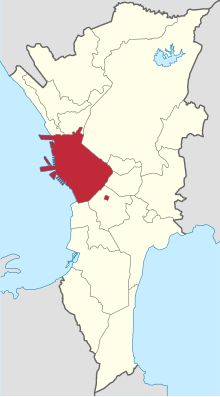| Manila's 2nd congressional district | |
|---|---|
| Constituency for the House of Representatives of the Philippines | |
Boundary of Manila's 2nd congressional district in Manila | |
 Location of Manila within Metro Manila | |
| City | Manila |
| Region | Metro Manila |
| Population | 212,938 (2020)[1] |
| Electorate | 152,929 (2022)[2] |
| Major settlements | East Tondo (Barangays 147–267) |
| Area | 4.08 km2 (1.58 sq mi) |
| Current constituency | |
| Created | 1907 |
| Representative | Rolando M. Valeriano |
| Political party | NUP Asenso Manileño |
| Congressional bloc | Majority |
Manila's 2nd congressional district is one of the six congressional districts of the Philippines in the city of Manila. It has been represented in the House of Representatives of the Philippines since 1916 and earlier in the Philippine Assembly from 1907 to 1916.[3] The district consists of barangays 147 to 267 in the eastern part of the Manila district of Tondo (also known as Gagalangin), east of Dagupan Street, Estero de Vitas and Estero de Sunog Apog bordering Navotas and southern Caloocan.[4] It is currently represented in the 19th Congress by Rolando M. Valeriano of the National Unity Party (NUP) and Asenso Manileño.[5]
Prior to the revision of Manila's city charter in 1949, it consisted of the southern and eastern Manila districts of Ermita, Malate, Paco, Pandacan, Quiapo, Sampaloc (including the present-day Santa Mesa), San Miguel, Santa Ana (including the present-day San Andres), and Santa Cruz. Following the revision and until its second dissolution in 1972, it retained Quiapo and Santa Cruz while Binondo and San Nicolas were added to its jurisdiction.[6] After the restoration of the Congress in 1987, it encompassed the eastern part of Tondo, which remains the case to the present.[4]
- ^ "TABLE 1. Population of legislative districts by Region, Province, and selected Highly Urbanized/Component City : 2020" (PDF). Philippine Statistics Authority. Retrieved June 17, 2022.
- ^ "Number and Turn-Out of Registered Voters and Voters Who Actually Voted by City/Municipality May 9, 2022 National and Local Elections". Commission on Elections. Retrieved January 11, 2023.
- ^ "Roster of Philippine legislators". House of Representatives of the Philippines. Retrieved March 20, 2020.
- ^ a b "The 1987 Constitution of the Republic of the Philippines". Chan Robles Virtual Law Library. Retrieved April 10, 2020.
- ^ "House Members". House of Representatives of the Philippines. Retrieved March 20, 2020.
- ^ Republic Act No. 409 (June 18, 1949), An act to revise the charter of the City of Manila, and for other purposes, Official Gazette of the Republic of the Philippines, retrieved October 27, 2023

